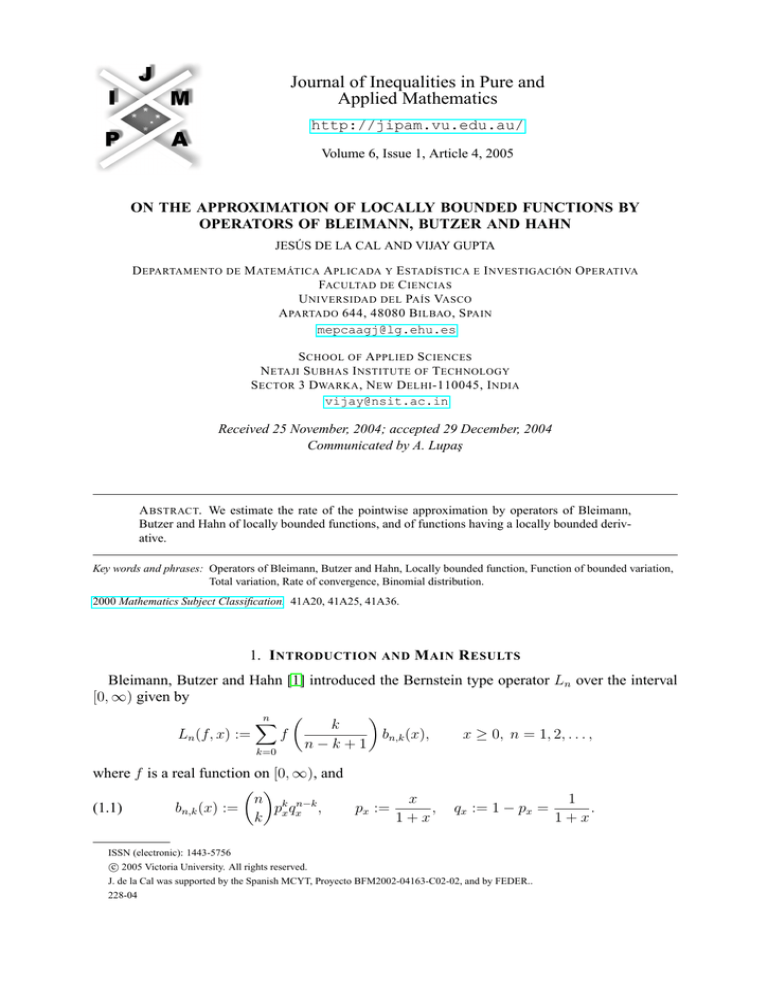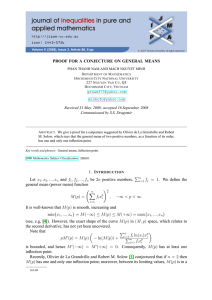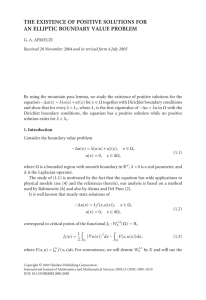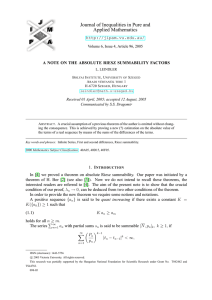
Journal of Inequalities in Pure and
Applied Mathematics
http://jipam.vu.edu.au/
Volume 6, Issue 1, Article 4, 2005
ON THE APPROXIMATION OF LOCALLY BOUNDED FUNCTIONS BY
OPERATORS OF BLEIMANN, BUTZER AND HAHN
JESÚS DE LA CAL AND VIJAY GUPTA
D EPARTAMENTO DE M ATEMÁTICA A PLICADA Y E STADÍSTICA E I NVESTIGACIÓN O PERATIVA
FACULTAD DE C IENCIAS
U NIVERSIDAD DEL PAÍS VASCO
A PARTADO 644, 48080 B ILBAO , S PAIN
mepcaagj@lg.ehu.es
S CHOOL OF A PPLIED S CIENCES
N ETAJI S UBHAS I NSTITUTE OF T ECHNOLOGY
S ECTOR 3 DWARKA , N EW D ELHI -110045, I NDIA
vijay@nsit.ac.in
Received 25 November, 2004; accepted 29 December, 2004
Communicated by A. Lupaş
A BSTRACT. We estimate the rate of the pointwise approximation by operators of Bleimann,
Butzer and Hahn of locally bounded functions, and of functions having a locally bounded derivative.
Key words and phrases: Operators of Bleimann, Butzer and Hahn, Locally bounded function, Function of bounded variation,
Total variation, Rate of convergence, Binomial distribution.
2000 Mathematics Subject Classification. 41A20, 41A25, 41A36.
1. I NTRODUCTION AND M AIN R ESULTS
Bleimann, Butzer and Hahn [1] introduced the Bernstein type operator Ln over the interval
[0, ∞) given by
n
X
k
Ln (f, x) :=
f
bn,k (x),
x ≥ 0, n = 1, 2, . . . ,
n−k+1
k=0
where f is a real function on [0, ∞), and
n k n−k
x
(1.1)
bn,k (x) :=
p x qx ,
px :=
,
k
1+x
qx := 1 − px =
ISSN (electronic): 1443-5756
c 2005 Victoria University. All rights reserved.
J. de la Cal was supported by the Spanish MCYT, Proyecto BFM2002-04163-C02-02, and by FEDER..
228-04
1
.
1+x
2
J ESÚS DE LA C AL AND V IJAY G UPTA
The approximation of uniformly continuous functions by these operators has been considered
in [1] – [4]. For other properties of Ln (preservation of global smoothness, preservation of φvariation, behavior of the iterates, etc.) we refer, for instance, to [4] – [10]. In some of the
mentioned works, the results are achieved by using probabilistic methods. This comes from the
fact that Ln is an operator of probabilistic type. We can actually write
Ln (f, x) = Ef (Zn,x ),
where E denotes mathematical expectation, and Zn,x is the random variable given by
Zn,x :=
(1.2)
Sn,x
,
n − Sn,x + 1
Sn,x := ξ1,x + · · · + ξn,x ,
where ξ1,x , ξ2,x , . . . are independent random variables having the same Bernoulli distribution
with parameter px , i.e.,
P (ξk,x = 1) = px = 1 − P (ξk,x = 0)
(so that Sn,x has the binomial distribution with parameters n, px ). This probabilistic representation also plays a significant role in the present paper (for a more refined representation useful
for other purposes, see [5, 6]).
Here, we discuss the approximation of real functions f on the semi axis which are locally
bounded, i.e., bounded on each finite subinterval of [0, ∞). In such a case, we set, for x > 0
and h ≥ 0,
ωx+ (f ; h) := sup |f (t) − f (x)|,
x≤t≤x+h
ωx− (f ; h)
:=
sup
|f (t) − f (x)|,
(x−h)+ ≤t≤x
ωx (f ; h) := ωx+ (f ; h) + ωx− (f ; h),
where (x − h)+ := max(x − h, 0), and we observe that these functions are (nonnegative and)
nondecreasing on [0, ∞). In particular, every continuous function is locally bounded. Also, if
f is locally of bounded variation, i.e., such that
b
_
(f ) < ∞,
0 ≤ a < b < ∞,
a
Wb
where a (f ) stands for the total variation of f on the interval [a, b], then f is locally bounded,
and we obviously have
x+h
_
(f ),
0 ≤ h ≤ x.
ωx (f ; h) ≤
x−h
This kind of problem has been already considered for other Bernstein-type operators (see, for
instance, [11] – [14] and the references therein). Our main results are stated as follows.
Theorem 1.1. Let g be a real locally bounded function on [0, ∞) such that g(t) = O(tr ) (t →
∞), for some r = 1, 2, . . . . If g is continuous at x > 0, then, for n large enough, we have
n
7(1 + x)2 X
1
x
(1.3)
|Ln (g, x) − g(x)| ≤
+ Or,x
.
ωx g; √
n
(n + 2)x k=1
k
In the following statements (and throughout the paper), we use the notations:
f ∗ (x) := f (x+) − f (x−)
f (x+) + f (x−)
f˜(x) :=
,
2
J. Inequal. Pure and Appl. Math., 6(1) Art. 4, 2005
http://jipam.vu.edu.au/
A PPROXIMATION O F L OCALLY B OUNDED F UNCTIONS B Y O PERATORS
3
fx := (f − f (x−))1[0,x) + (f − f (x+))1(x,∞)
(1A being the indicator function of the set A), provided that the lateral limits f (x+) and f (x−)
exist (such a condition is fulfilled when f is locally of bounded variation). We also use the
symbol bac to indicate the integral part of the real number a.
Theorem 1.2. Let f be a real locally bounded function on [0, ∞) such that f (t) = O(tr ) (t →
∞), for some r = 1, 2, . . . . If x > 0, and f (x+) and f (x−) exist, then we have for n large
enough
Ln (f, x) − f˜(x)
≤ ∆n,x (fx ) +
1.6 + x + 2.6 x2 |f ∗ (x)| n,x (1 + x)
√
·
+ √
|f (x) − f (x−)|,
2
nx(1 + x)
2enx
where ∆n,x (fx ) is the right-hand side of (1.3) with g replaced by fx , and
(
1 if (n + 1)px ∈ {1, 2, . . . , n}
n,x :=
0 otherwise.
Theorem 1.3. Let g be a real function on [0, ∞) such that g(t) = O(tr )
r = 1, 2, . . . , and having the form
Z t
g(t) = c +
f (u) du,
t ≥ 0,
(t → ∞), for some
0
where c is a constant and f is measurable and locally bounded on [0, ∞). If x > 0, and f (x+)
and f (x−) exist, then we have for n large enough
√
+ x) ∗ Ln (g, x) − g(x) − x(1
√
f (x)
2πn
√
nc
x
2 bX
5(1 + x)
≤
ωx fx ;
+|f ∗ (x)| ox n−1/2 +Or,x (n−1 ).
n + 2 k=1
k
The proofs of the preceding theorems are given in Sections 3 – 5. In Section 2, we collect the
necessary auxiliary results. Some remarks on moments close the paper.
2. AUXILIARY R ESULTS
∗
In the following lemma, Φ denotes the standard normal distribution function, and Fn,x
stands
√
∗
npx qx ,, where Sn,x is the same as in
for the distribution function of Sn,x := (Sn,x − npx )
(1.2). Such a lemma is nothing but the application of the well-known Berry-Esseen theorem
(cf. [15]) to the situation at hand.
Lemma 2.1. We have, for x > 0 and n ≥ 1,
sup
−∞<t<∞
∗
|Fn,x
(t) − Φ(t)| ≤
0.8(1 + x2 )
0.8(p3x qx + px qx3 )
√
√
=
.
n(px qx )3/2
nx(1 + x)
Lemma 2.2. Let x > 0 and n ≥ 1. Then, we have:
(a)
Ln ((· − x)2 , x) = E(Zn,x − x)2 ≤
J. Inequal. Pure and Appl. Math., 6(1) Art. 4, 2005
3x(1 + x)2
.
n+2
http://jipam.vu.edu.au/
4
J ESÚS DE LA C AL AND V IJAY G UPTA
(b)
P (Zn,x ≤ x − h) + P (Zn,x ≥ x + h) ≤
3x(1 + x)2
,
(n + 2)h2
h > 0.
(c)
r
|P (Zn,x > x) − P (Zn,x ≤ x)| ≤
1.6(1 + x2 )
x
.
+√
n
nx(1 + x)
(d)
Ln ((· − x), x) = E(Zn,x − x) = −xpnx = ox (n−1 ),
(n → ∞).
(e)
√
Ln (| · −x|, x) = E|Zn,x − x| =
2x(1 + x)
√
+ ox (n−1/2 ),
πn
(n → ∞).
Proof. Part (a) was shown in [10]. Part (b) follows from (a) and the fact that, by Markov’s
inequality,
P (Zn,x ≤ x − h) + P (Zn,x
E(Zn,x − x)2
≥ x + h) = P (|Zn,x − x| ≥ h) ≤
.
h2
To show (c), observe that
|P (Zn,x > x) − P (Zn,x ≤ x)|= |1 − 2P (Zn,x ≤ x)|
= |1 − 2P (Sn,x ≤ (n + 1)px )|
r x ∗
= 1 − 2Fn,x
n r r r x
x
x ∗
+ 1 − 2Φ
≤ 2 Φ
− Fn,x
.
n
n
n Thus, the conclusion in part (c) follows from Lemma 2.1 and the fact that (cf. [16])
2 1/2
0 < 2Φ(t) − 1 ≤ 1 − e−t
≤ t,
(t > 0).
Part (d) is immediate. Finally, to show (e), let m := b(n + 1)px c. We have
m X
k
Ln (| · −x|, x) − Ln ((· − x), x)= 2
x−
bn,k (x)
n−k+1
k=0
= 2x
m
X
k=0
= 2x
m
X
k=0
bn,k (x) − 2
m
X
k=1
bn,k (x) − 2x
n!
pkx qxn−k
(k − 1)!(n − k + 1)!
m−1
X
bn,k (x)
k=0
= 2x bn,m (x)
√
2x(1 + x)
√
+ ox (n−1/2 ),
=
πn
(n → ∞),
the last equality by [13, Lemma 1], and the conclusion follows from (d).
J. Inequal. Pure and Appl. Math., 6(1) Art. 4, 2005
http://jipam.vu.edu.au/
A PPROXIMATION O F L OCALLY B OUNDED F UNCTIONS B Y O PERATORS
5
Lemma 2.3. Let x > 0 and r = 1, 2, . . . . Then, we have for all integers n such that (n +
1)(p2x − p3x/2 ) ≥ r,
X
k∈K
r n o s−1
X
kr
r x (1 + x)r−s+2
n!
b
(x)≤
12
r!
·
n,k
(n − k + 1)r
s
n + r − s + 2 (n + r − s)!
s=1
= Or,x (n−1 ),
(n → ∞),
r
where the s are the Stirling numbers of the second kind, and K is the set of all integers k
such that n ≥ k > (n − k + 1)2x (i.e., n ≥ k > (n + 1)p2x ).
Proof. Using the well known identity
r n o
X
r
a(a − 1) · · · (a − s + 1),
ar =
s
s=1
we can write
r
(2.1)
X
k∈K
X nro
kr
b
(x)
=
As ,
n,k
(n − k + 1)r
s
s=1
where
As :=
X k(k − 1) · · · (k − s + 1)
(n − k + 1)r
k∈K
=
X
k∈K
bn,k (x)
1
n!
·
pk q n−k .
r
(n − k + 1) (k − s)!(n − k)! x x
Since
r Y
1
n−k+i
1
=
(n − k + 1)r i=1 n − k + i n − k + 1
r Y
1
i−1
=
1+
n−k+i
n−k+1
i=1
≤
r
Y
i=1
i
r!(n − k)!
=
,
n−k+i
(n − k + r)!
we have
As ≤ r!
X
k∈K
n!
pkx qxn−k
(k − s)!(n − k + r)!
n!
n−l−s
pl+s
x qx
l!(n + r − s − l)!
l∈Ks
r!n!psx qx−r X n + r − s
xl
=
(n + r − s)! l∈K
l
(1 + x)n+r−s
s
r!n!psx qx−r X n + r − s
xl
≤
,
(n + r − s)! l∈K 0
l
(1 + x)n+r−s
= r!
X
where Ks := {k − s : k ∈ K}, and K 0 stands for the set of all integers l such that n ≥ l >
(n − l + 1)(3x/2) (observe that, by the assumption on n, we have Ks ⊂ K 0 ). The probabilistic
J. Inequal. Pure and Appl. Math., 6(1) Art. 4, 2005
http://jipam.vu.edu.au/
6
J ESÚS DE LA C AL AND V IJAY G UPTA
interpretation of the last sum together with Lemma 2.2(b) yield
r!n!xs (1 + x)r−s
3x
As ≤
P Zn+r−s,x >
(n + r − s)!
2
s−1
r−s+2
12 r!n!x (1 + x)
(2.2)
≤
,
(n + r − s)!(n + r − s + 2)
and the conclusion follows from (2.1) and (2.2).
Remark 2.4. The same procedure as in the preceding proof leads to the following upper bound
for the integral moments of Ln (or Zn,x ):
Ln (tr , x) = E(Zn,x )r
n
X
kr
b (x)
=
r n,k
(n
−
k
+
1)
k=0
r n o
X
r n!xs (1 + x)r−s
≤ r!
.
s
(n
+
r
−
s)!
s=1
3. P ROOF OF T HEOREM 1.1
Without loss of generality, we assume that g(x) = 0. Denote by Kn,x the distribution function
of Zn,x , i.e.,
X
Kn,x (t) := P (Zn,x ≤ t) =
bn,k (x)
t ≥ 0.
k≤(n−k+1)t
We can write Ln (g, x) as the Lebesgue-Stieltjes integral
Z
Ln (g, x) = Eg(Zn,x ) =
g(t) dKn,x (t) =
4 Z
X
[0,∞)
j=1
g(t) dKn,x (t),
Ij
where
x
I1 := 0, x − √ ,
n
x
I3 := x + √ , 2x
n
I2 :=
and
x
x
x − √ ,x + √ ,
n
n
I4 := (2x, ∞).
We obviously have
Z
x
|g(t)| dKn,x (t)≤ ωx g; √
dKn,x (t)
n
I2
I2
x
≤ ωx g; √
n
n
1X
x
≤
ωx g; √
.
n k=1
k
Z
(3.1)
On the other hand, from the asymptotic assumption on g, we have
|g(t)| ≤ M tr ,
J. Inequal. Pure and Appl. Math., 6(1) Art. 4, 2005
t ≥ α,
http://jipam.vu.edu.au/
A PPROXIMATION O F L OCALLY B OUNDED F UNCTIONS B Y O PERATORS
7
for some constants M > 0 and α ≥ 2x. Therefore,
Z
Z
Z
|g(t)| dKn,x (t)=
+
|g(t)| dKn,x (t)
I4
(2x,α]
(α,∞)
X
≤ ωx+ (g; α − x)P (Zn,x > 2x) + M
k>(n−k+1)α
By Lemma 2.2(b) and Lemma 2.3, this shows that
Z
(3.2)
|g(t)| dKn,x (t) = Or,x (n−1 )
kr
bn,k (x).
(n − k + 1)r
(n → ∞).
I4
Finally, using Lemma 2.2(b) and integration by parts (follow the same procedure as in the proof
of Theorem 1 in [13]), we obtain
Z
Z
|g(t)| dKn,x (t)≤
ωx− (g; x − t) dKn,x (t)
I1
I1
#
"
Z x−x/√n −
ωx (g; x − t)
3x(1 + x)2 ωx− (g; x)
dt
≤
+2
(x − t)3
(n + 2)
x2
0
n
6(1 + x)2 X −
x
≤
ω
g; √
(3.3)
,
(n + 2)x k=1 x
k
and, analogously,
n
6(1 + x)2 X +
x
ω
g; √
|g(t)| dKn,x (t) ≤
.
(n + 2)x k=1 x
k
I3
Z
(3.4)
The conclusion follows from (3.1) – (3.4).
4. P ROOF OF T HEOREM 1.2
We can write, for t ≥ 0,
f ∗ (x)
f (t) − f˜(x) = fx (t) +
σx (t) + (f (x) − f˜(x))δx (t),
2
where σx := −1[0,x) + 1(x,∞) , and δx := 1{x} is Dirac’s delta at x (this is the so called BojanicVuilleumier-Cheng decomposition).
By Theorem 1.1, we have
(4.1)
|Ln (fx , x)| ≤ ∆n,x (fx ),
(4.2)
where ∆n,x (fx ) is the right-hand side of (1.2) with g replaced by fx . Moreover,
Ln (σx , x)= P (Zn,x > x) − P (Zn,x < x)
(4.3)
= (P (Zn,x > x) − P (Zn,x ≤ x)) + P (Zn,x = x),
and
(4.4)
Ln (δx , x) = P (Zn,x = x).
Using Lemma 2.2(c) and the fact that (cf. [17, Theorem 1])
( n k n−k
if (n + 1)px = k ∈ {1, 2, . . . , n}
p q
≤ √(1+x)
k x x
2enx
P (Zn,x = x) =
0
otherwise,
the conclusion readily follows from (4.1) – (4.4).
J. Inequal. Pure and Appl. Math., 6(1) Art. 4, 2005
http://jipam.vu.edu.au/
8
J ESÚS DE LA C AL AND V IJAY G UPTA
5. P ROOF OF T HEOREM 1.3
Using the decomposition (4.1), it is easily checked that
Ln (g, x) − g(x) =
(5.1)
4
X
Ai (n, x),
i=1
where
f ∗ (x)
A1 (n, x) := f˜(x)Ln ((· − x), x) +
Ln (| · −x|, x),
2
Z x
Z
A2 (n, x) :=
fx (u) du dKn,x (t),
[0,x]
Z
t
t
Z
A3 (n, x) :=
fx (u) du dKn,x (t),
(x,2x]
Z
x
Z
A4 (n, x) :=
t
fx (u) du dKn,x (t),
(2x,∞)
x
and Kn,x (t) is the same as in the preceding proofs.
From Lemma 2.2(d,e), we have
√
x(1 + x) ∗
f (x) + f ∗ (x) ox (n−1/2 ) + ox (n−1 ),
(n → ∞).
(5.2)
A1 (n, x) = √
2πn
Next, we estimate A2 (n, x). By Fubini’s theorem,
!
Z x
Z x−x/√n Z x
A2 (n, x) =
Kn,x (u) fx (u) du =
+
Kn,x (u) fx (u) du.
√
0
0
x−x/ n
It is clear that
Z x
≤
K
(u)
f
(u)
du
|fx (u)| du
n,x
x
√
√
x−x/ n
x−x/ n
Z x
≤
ωx− (fx ; x − u) du
√
x−x/ n
x
x −
≤ √ ωx fx ; √
n
n
√
b nc
2x X − x ≤
ω fx ;
,
n k=1 x
k
Z
x
and, using Lemma 2.2(b),
Z
x−x/√n
3x(1 + x)2 Z x−x/√n |f (u)|
x
Kn,x (u) fx (u) du≤
du
0
(n + 2)
(x − u)2
0
√
Z
3x(1 + x)2 x−x/ n ωx− (fx ; x − u)
≤
du
(n + 2)
(x − u)2
0
Z √n
x
3(1 + x)2
≤
ωx− fx ;
dt
(n + 2) 1
t
√
nc
x
2 bX
3(1 + x)
≤
ωx− fx ;
.
n + 2 k=1
k
J. Inequal. Pure and Appl. Math., 6(1) Art. 4, 2005
http://jipam.vu.edu.au/
A PPROXIMATION O F L OCALLY B OUNDED F UNCTIONS B Y O PERATORS
9
We therefore conclude that
√
nc
2 bX
5(1 + x)
|A2 (n, x)| ≤
n+2
(5.3)
x
fx ;
.
k
ωx−
ωx+
k=1
Similarly,
√
nc
2 bX
5(1 + x)
|A3 (n, x)| ≤
n+2
(5.4)
k=1
x
fx ;
.
k
Finally,
Z
Z
g(t) dKn,x (t) −
A4 (n, x) =
(2x,∞)
[g(x) + f (x+)(t − x)] dKn,x (t),
(2x,∞)
and, by the asymptotic assumption on g, Lemma 2.2(b) and Lemma 2.3, we obtain
(5.5)
|A4 (n, x)| = Or,x (n−1 ),
(n → ∞).
The conclusion follows from (5.1) – (5.5).
6. R EMARKS ON M OMENTS
Fix x > 0, and let g(·) := | · −x|β , with β > 2. Since
ωx (g, h) = 2 hβ ,
and
n
X
0 ≤ h ≤ x,
k −β/2 = O(1),
(n → ∞),
k=1
we conclude from Theorem 1.1 that
Ln (| · −x|β , x) = Or,x (n−1 ),
(n → ∞).
In the case that 0 < β ≤ 2, we have, by Jensen’s inequality (or Hölder’s inequality) and
Lemma 2.2(a),
β2
2
3x(1
+
x)
β/2
Ln (| · −x|β , x) = E|Zn,x − x|β ≤ E(Zn,x − x)2
≤
,
n+2
for all n ≥ 1.
R EFERENCES
[1] G. BLEIMANN, P.L. BUTZER AND L. HAHN, A Bernstein-type operator approximating continuous functions on the semi axis, Indag. Math., 42 (1980), 255–262.
[2] V. TOTIK, Uniform approximation by Bernstein-type operators, Indag. Math., 46 (1984), 87–93.
[3] R.A. KHAN, A note on a Bernstein type operator of Bleimann, Butzer and Hahn, J. Approx. Theory,
53 (1988), 295–303.
[4] R.A. KHAN, Some properties of a Bernstein type operator of Bleimann, Butzer and Hahn, In
Progress in Approximation Theory, (Edited by P. Nevai and A. Pinkus), pp. 497–504, Academic
Press, New York (1991).
[5] J.A. ADELL AND J. DE LA CAL, Preservation of moduli of continuity for Bernstein-type operators, In Approximation, Probability, and Related Fields, (Edited by G. Anastassiou and S.T.
Rachev), pp. 1–18, Plenum Press, New York (1994).
J. Inequal. Pure and Appl. Math., 6(1) Art. 4, 2005
http://jipam.vu.edu.au/
10
J ESÚS DE LA C AL AND V IJAY G UPTA
[6] J.A. ADELL AND J. DE LA CAL, Bernstein-type operators diminish the φ-variation, Constr. Approx., 12 (1996), 489–507.
[7] J.A. ADELL, F.G. BADíA AND J. DE LA CAL, On the iterates of some Bernstein-type operators,
J. Math. Anal. Appl., 209 (1997), 529–541.
[8] B. DELLA VECCHIA, Some properties of a rational operator of Bernstein type, In Progress in
Approximation Theory, (Edited by P. Nevai and A. Pinkus), pp. 177–185, Academic Press, New
York (1991).
[9] U. ABEL AND M. IVAN, Some identities for the operator of Bleimann-Butzer-Hahn involving
divided differences, Calcolo, 36 (1999), 143–160.
[10] U. ABEL AND M. IVAN, Best constant for a Bleimann-Butzer-Hahn moment estimation, East J.
Approx., 6 (2000), 1–7.
[11] S. GUO AND M. KHAN, On the rate of convergence of some operators on functions of bounded
variation, J. Approx. Theory, 58 (1989), 90–101.
[12] V. GUPTA AND R.P. PANT, Rate of convergence for the modified Szász-Mirakyan operators on
functions of bounded variation, J. Math. Anal. Appl., 233 (1999), 476–483.
[13] X.M. ZENG AND F. CHENG, On the rates of approximation of Bernstein type operators, J. Approx.
Theory, 109 (2001), 242–256.
[14] X.M. ZENG AND V. GUPTA, Rate of convergence of Baskakov-Bézier type operators for locally
bounded functions, Computers. Math. Applic., 44 (2002), 1445–1453.
[15] A.N. SHIRYAYEV, Probability, Springer, New York (1984).
[16] N.L. JOHNSON, S. KOTZ AND N. BALAKRISHNAN, Continuous Univariate Distributions, Vol.
1, 2nd Edition, Wiley, New York (1994).
[17] X.M. ZENG, Bounds for Bernstein basis functions and Meyer-König and Zeller basis functions, J.
Math. Anal. Appl., 219 (1998), 364–376.
J. Inequal. Pure and Appl. Math., 6(1) Art. 4, 2005
http://jipam.vu.edu.au/










